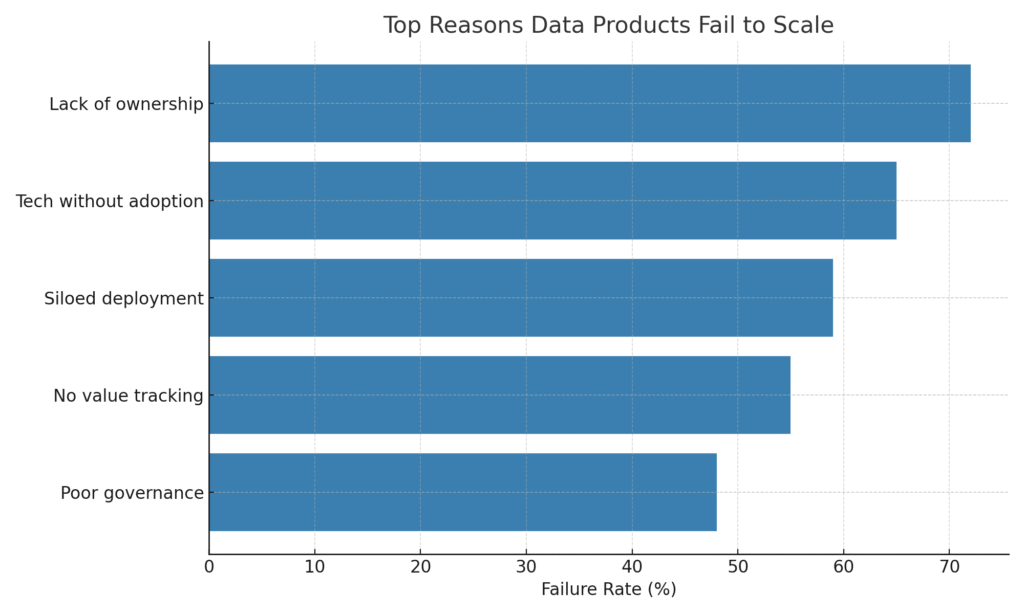Overcoming the Missing Link Between Pilots and Real Business Value
Executive Summary
Many organisations have built dashboards, trained data scientists, and launched pilots—but few have managed to scale data products in a way that drives sustained business value. Pulse Infra addresses the ‘missing link’ by aligning data initiatives with real operational problems, designing reusable analytics assets, and embedding products into daily workflows. This whitepaper explains why many data products fail, what separates scalable ones from stranded experiments, and how Pulse Infra turns analytics into strategic, repeatable infrastructure.
The Promise and Pitfall of Data Product Thinking
The idea of treating analytics solutions as ‘products’—with users, feedback loops, and lifecycle management—is gaining traction. However, this approach often collapses under unclear ownership, tech-centric execution, or lack of governance. According to Gartner, up to 85% of data projects fail to deliver measurable impact. Pulse Infra helps organisations bridge the gap from isolated insight to scaled solution.

Figure 1: Most common reasons why data products fail to scale across enterprise operations.
1. The Most Common Failure Points
Based on Pulse Infra’s project reviews, these are the five root causes:
– Lack of clear business ownership or user sponsorship
– Technology-first mindset without user validation
– Deployment without integration into processes or decisions
– No framework for measuring product adoption or business value
– Weak governance and version control for evolving models
2. Pulse Infra’s Framework for Scalable Data Products
To overcome these challenges, Pulse Infra delivers a four-stage framework:
1. **Problem-to-Product Mapping** – Frame analytics around recurring business decisions, not exploratory models
2. **Reusable Design** – Ensure models, pipelines, and metrics can be adapted across similar domains
3. **Embedded Delivery** – Build UX, APIs, and workflow hooks that match how users already work
4. **Lifecycle Governance** – Define ownership, updates, and success metrics from the start
3. Case Snapshots: Scaled Data Products in Action
– In the infrastructure sector, Pulse helped a national rail operator standardise failure risk models across 12 regions, reducing engineering effort by 30%.
– In a GCC government agency, Pulse packaged its capital planning algorithm into a data product reused across 9 departments—accelerating project approvals by 42%.
– For a regional airport, Pulse built an asset condition index product that linked directly to their EAM system—driving 17% uplift in preventive maintenance compliance.
4. What It Takes to Scale Successfully
Scalable data products rely on:
– Clearly defined product owners and domain champions
– Interdisciplinary teams (data, ops, UX, and product)
– Architectural support: cloud-native, secure, governed
– Continuous feedback and value demonstration
Pulse Infra supports organisations in standing up Data Product Offices and designing scalable product backlogs aligned to business outcomes.
Global Views on Data Productisation
“The real value of data is only unlocked when it’s turned into repeatable, trusted, and embedded services.”
– Samantha Varga, Chief Data Officer, Transit Infrastructure Group
“Scaling data is not a tech problem—it’s an organisational maturity challenge.”
– Ali Bader, Head of Analytics Governance, GCC Smart Cities Consortium
Conclusion: Making Analytics Operational, At Scale
Many organisations have built the technical ingredients for analytics but lack the connective tissue for impact. Pulse Infra bridges this gap through product thinking, outcome orientation, and governance maturity. Data at scale means more than infrastructure—it means institutionalising decisions, not just insights.
